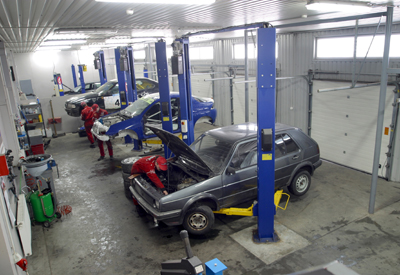Emissions Reduction

Clean Air Minnesota Autobody Refinishers Training and Technology Demonstration Pilot Project
In 2008, the Minnesota Environmental Initiative (MEI) (now Environmental Initiative), provided outreach to Twin Cities auto body shops in an effort to reduce emissions of ozone precursors and air toxics produced by this industry. The Auto Body Training and Technology Demonstration Pilot Project (Auto Body Project) targeted the auto body refinishing industry, which is among the top 15 area sources of volatile organic compounds (VOCs) and among the top 10 sources of hazardous air pollutants (HAPs) in Minnesota. Auto body shop emissions affect air quality near shops, pose health risks to workers, and contribute to climate change.
In fulfilling the project’s goals, MEI researched and compiled recommended emission reduction practices and technologies, identified industry leaders using these techniques, and hosted a free training and demonstration event on August 27, 2008 demonstrating best practices to shop owners. Next MEI facilitated the implementation of pilot trials in several local body shops. Outcomes from the pilot trial participants are documented below.
The final report documenting MEI’s Auto Body Project is available for download.
Pilot Trial Outcomes
MEI identified use of paint thinner/solvent as a cleaning agent in auto body shops as a significant source of air toxics and targeted pilot trial implementation at replacing solvent products with a non-hazardous alternative or reducing thinner usage through solvent recycling equipment.
Five local shops participated in MEI pilot trials, three of which have permanently adopted practices that result in reduced air emissions from solvent usage.
- Jerry’s Auto Body in Stillwater and Bon Auto Body in Richfield are both using a non-toxic, non-hazardous alternative solvent (Eco-Chem GW1) in place of traditional solvent for a combined annual reduction in air emissions of over 230 lbs.
- Lehman’s Garage in Bloomington and Crystal Lake Automotive also tested the alternative solvent product, but did not permanently adopt it.
- With assistance from MEI, Maaco – Little Canada purchased a new 5-gallon Always Clean 110 Solvent Recycler through Onsite Recycling Services that will save the shop hundreds of dollars annually and reduce annual air emissions by approximately 730 lbs.
Project Funders
- U.S. Environmental Protection Agency
- Flint Hills Resources
Shops looking to upgrade equipment or improve environmental performance can benefit from financial assistance offered through these programs:
- MPCA’s Small Business Environmental Improvement Loan Program. The MPCA offers the Small Business Environmental Improvement Loan Program as a means to help small businesses help themselves with environmental projects. The program provides low-interest loans to small businesses to finance environmental projects such as capital equipment upgrades that meet or exceed environmental regulations, and costs associated with the investigation and cleanup of contaminated sites.
- Minnesota Department of Labor and Industry’s Safety Grants. Minnesota OSHA’s Safety Grant Program awards funds up to $10,000 to qualifying employers for projects designed to reduce the risk of injury and illness to their workers.
- Minnesota Department of Commerce Energy Office The Minnesota Department of Commerce provides resources and opportunities to residential and commercial customers, including energy efficiency information, resources for funding energy conservation projects, and links to utility Conservation Improvement Programs (CIPs) that help customers cut energy usage and save money.
Best Practices
MEI’s project identified a number of resources shop owners and collision repair professionals can consult regarding best practices for emission reduction.
- The U.S EPA Safer Choice Program has developed a comprehensive toolkit for use in the collision repair industry that assists individual shops with increasing awareness of the health and environmental concerns associated with refinishing activities and identifying and encouraging the use of safer, cleaner, and more efficient practices and technologies.
- CCAR-GreenLink® Virtual Shops. The Coordinating Committee for Automotive Repair’s (CCAR’s) virtual collision repair shop, virtual paint mixing room, and virtual spray booth demonstrate the essential features of auto body refinishing operations in full compliance.
Resources
- Collision Repair Campaign to Reduce Toxics. U.S. EPA’s Collision Repair Campaign aims to drastically reduce auto body emissions at the national level.
- Collision Auto Repair Safety Study (MN-CARSS). The CARSS program has been funded by the National Institute for Occupational Safety and Health (NIOSH). The goal of the CARSS program is to improve worksite health and safety management practices and lower health and safety risks in collision repair shops. Choosing the Right Gloves [PDF 1,672KB] provides tips on how to find the right gloves for the chemicals you are working with.
- Fleet Fuel Efficiency/Alternative Fuels Resources. Many opportunities exist to reduce fuel consumption and/or increase utilization of alternative fuels by fleets. Much information has been developed and made available by a variety of government programs and other organizations. This site has been developed to compile these information and assistance resources and make them readily accessible.